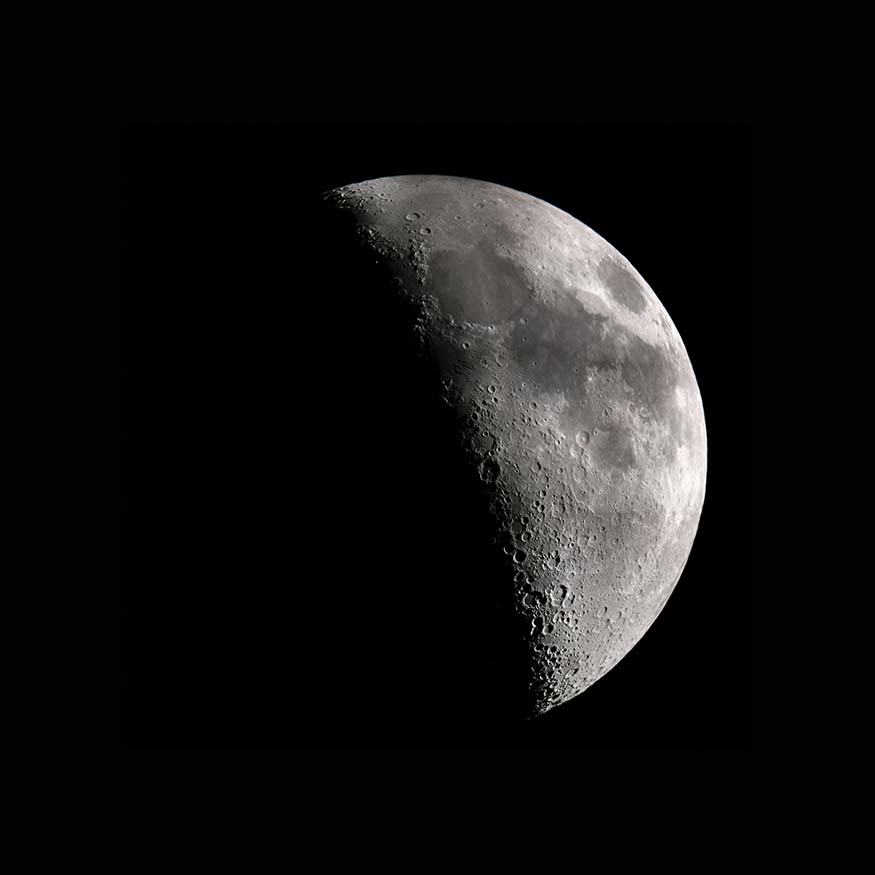
BEAUTY: 
BRAGGING RIGHTS: A beautiful sight
HOW EASY IS IT TO SEE? Best with binoculars or small telescope
TYPE: Moon
DISCOVERED: Known since antiquity
It’s easy to take the moon for granted. You’re not going to impress someone at a party by saying you saw the moon. But viewing the moon under just a small amount of magnification, with binoculars or a telescope, is enough to make you reconsider. The familiar dark and light splotches on the moon are transformed into a vast desert plain surrounded by fields of overlapping craters.
When you look at the moon you are looking at the surface of another world. Through a telescope you can almost feel that you’re flying above the cratered highlands of that alien land. It doesn’t take much imagination to see it as a real world that you could walk on, as 12 astronauts once did.
If you use binoculars, make sure you set them up on a tripod so you can take your time looking at all the detail. But a small or medium telescope is preferable, as it helps you zoom in as much as the viewing conditions will allow.
The best time to look at the moon’s surface is around the time it is half full. The area between light and dark, called the terminator, is where you’ll see the best detail. There, the light from the sun hits the surface at a low angle, causing long shadows that you can see clearly from Earth. All of the hills, craters, and valleys will appear much more prominent at the terminator.
WHAT YOU MIGHT SEE THROUGH AMATEUR EQUIPMENT
The moon is also the easiest object to photograph through a telescope. Once you’ve pointed your telescope at the moon, all you need to do is point your digital camera (or phone camera) through the eyepiece and just start snapping away. If you can, set the exposure to be 1/60th of a second or faster to keep the image sharp. You may also want to increase the ISO (for more sensitivity) and adjust the white balance (to capture the moon’s neutral gray). Practice, as always, will pay off.
Maria vs. highlands. The first thing you’ll notice is the difference between the darker, flat maria and the rugged and cratered highlands. Ancient astronomers speculated that the flat areas were seas, and named them as such (mare is Latin for sea and maria is the plural form). But today we know that maria are ancient fields of lava.
Early in the moon’s history it was bombarded by meteors, which created many of the craters you see. Soon afterwards, volcanic lava flows covered over some of these craters forming the maria.
Tycho crater. One of the most prominent craters is Tycho. Notice how it’s surrounded by “rays” that emanate from it and reach far away, even to some nearby maria. These rays consist of ejecta—molten rock that was hurled into the air from the original collision that made the crater. The fact that we can still see the ejecta means that Tycho is a relatively young crater, probably only 100 million years old.
Mare Crisium. Mare Crisium is a small area, notable for being completely surrounded by highlands. The edges of this mare are filled with interesting details: small mountain ridges, half-eroded craters, and even a couple of smaller maria. Since this area is near one edge, you should wait until a couple of days after a full moon for the lighting to be right to observe it.
Clavius crater. It’s worth comparing this crater to nearby Tycho. Clavius is much larger, but clearly older, since later impacts have produced craters on top of it. Some craters have obliterated some of Clavius’s walls; others have hit right inside.
These are just a few highlights of the lunar surface, but there is so much to see on the moon that we can’t fit it all here. Take your time to explore on your own.